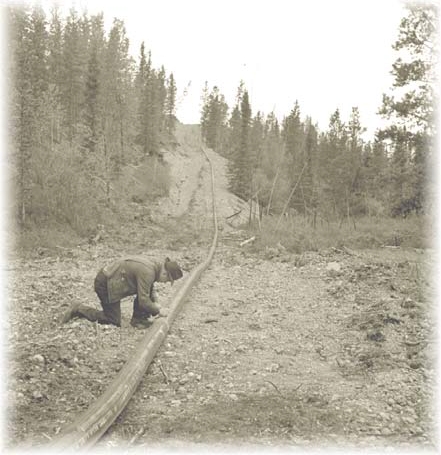As Canada continues to pursue economic growth via continued resource extraction, an increasing number of new pipeline proposals are under review. Amidst these, we feel there are important and contemporarily relevant lessons to be learned from the Canol about the challenges encountered, and what the environmental and human costs of such projects are. In turn, the Canol Doc Project will capture the positive potential that lies within repurposed, post-industrial landscapes.
The Canol pipeline was built to carry crude oil from Norman Wells, Northwest Territories, in Canada to Alaska, USA, during World War II. The routing was to Johnson Crossing and then along the Alaska highway to Whitehorse, Yukon, where a refinery was built.
The pipeline’s main line was in use for less than fourteen months. The Canol pipeline actually consisted of four sections. Although the Norman Wells section was shut down, oil was received from Skagway and pumped to Fairbanks and a pipeline was also extended from Whitehorse to Watson Lake. The pipeline’s route is now a wilderness hiking trail—the Canol Heritage Trail.
Even though the pipeline was on Canadian territory, as a wartime expediency the building of the pipeline was overseen by the United States Army. Local workers were employed as well as civilians recruited in the South. Recruiting ads warned candidates not to apply unless they were prepared for the “harshest possible conditions”.
Construction began in 1942, and was completed in April 1944. The pipeline was just 4 inches (10 cm) in diameter. The light crude oil from Norman Wells could be run through a narrow pipeline without being heated, where heavier crude requires heating.
when the war ended, American forces had simply abandoned all their infrastructure, making no effort to remediate the environmental damage the pipeline had caused.
A group was made so that they can go through parts of trail and do some explorations. Other than that their detailed objectives could include:
- Labor and migration during the construction of the pipeline
- Political and environmental history of the Sahtu region and pipeline
- Economic, climatic, and social cost of the pipeline
- First Nations’ sentiment about the pipeline, historic and contemporary
- Current regional development plans for natural resource extraction
And they made a documentary from their trip.
Beginning in Ross River, our crew will ride 250 kilometers on recognizable road to the border of the the Yukon and North West Territories. From there we will resupply and begin our journey on the 350 kilometer Canol Heritage Trail. Due to its remoteness, ruggedness, notable elevation change, and its’ series of difficult river crossings, the Canol is considered to be one of the most challenging wilderness routes in Canada.
The trail weaves through the taiga cordillera (alpine tundra and lowland forests) ecozone, as part of the northernmost portion of the Rocky Mountains. The waterways and biota we will encounter are diverse and fragile, and many of the valleys, rivers, and mountains hold vital spiritual and cultural importance for the Shutagot’ine (Sahtu Mountain Dene) and the Sahtu Metis of Tulita and Norman Wells. They recognized that engagement with Sahtu lifeways and ecological knowledge will be essential in coming to respect the beauty and importance of the land they planned to move through.
Unfortunately this talk was not directly related to my topic but the more we know the more comprehensive view we can have.
She answered almost all of questions well. I don’t have any further questions.


Recent Comments